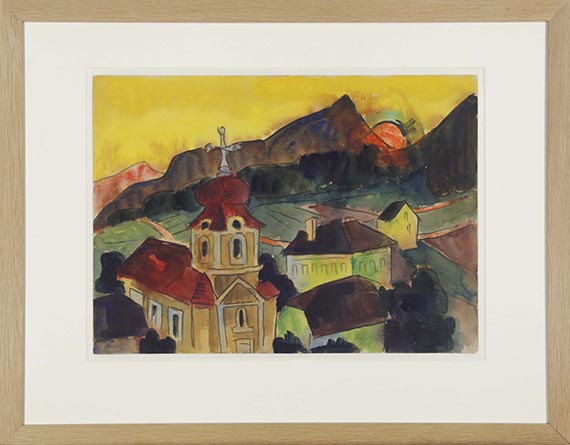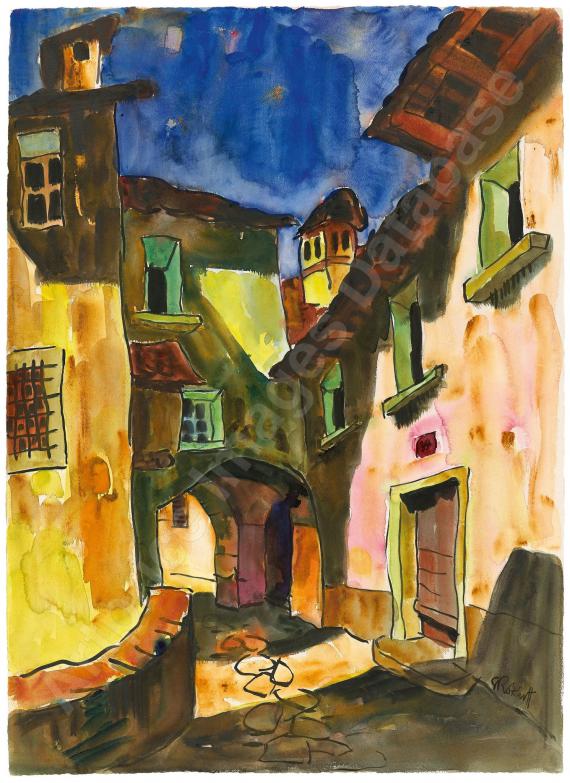Frame image
245
Karl Schmidt-Rottluff
Gebirgsdorf mit Kirche, Um 1925.
Watercolor
Estimate:
€ 40,000 - 60,000
$ 44,000 - 66,000
Gebirgsdorf mit Kirche. Um 1925.
Watercolor.
Signed lower right. On firm wove paper. 49.5 x 68.5 cm (19.4 x 26.9 in), the full sheet.
[KA].
• An extremely rare motif offered on the international auction market for the first time (source: artprice.com).
• Karl Schmidt-Rottluff's masterly transformation of the atmospheric panoramic view into a dynamic composition with verticals, horizontals, and diagonals, as well as with expressive color effects.
• Watercolors are predominant in Schmidt-Rottluff's oeuvre, from the years of the “Brücke” to his last creative phase in the 1970s.
The work is documented in the archive of the Karl and Emy Schmidt-Rottluff Foundation, Berlin.
PROVENANCE: Presumably Kunstausstellung Kühl, Dresden (with the handwritten note “Kuehl” on the reverse).
Dr. Hildebrand Gurlitt, Hamburg/Dresden/Aschbach (until December 5, 1945).
Neue Residenz, Bamberg (seized from the possession of the above)
Central Collecting Point, Wiesbaden (transferred from above location, with a handwritten note on reverse, inventory no. Wie 1977/5).
Dr. Hildebrand Gurlitt, Düsseldorf (returned to the above, until November 9, 1956, with stamp on the reverse “Mannesmann-Ufer 9”).
Helene Gurlitt, Düsseldorf/Munich (inherited from the above in 1956, until 1960).
Berthold and Else Beitz Collection, Essen (acquired from the above through the agency of Galerie Wilhelm Grosshennig, Düsseldorf, in 1960).
In family ownership since.
EXHIBITION: Presumably: German Watercolors Drawings and Prints 1905-1955. A Mid-Century Review with Loans from German Museums and Galleries and from the collection Dr. H. Gurlitt, Duesseldorf (A loan exhibition sponsored by the Federal Republic of Germany and circulated by the American Federation of Arts), traveling exhibition Grace Borgenicht Gallery, New York, Weyhe Gallery, New York, Busch-Reisinger Museum at Harvard University, Cambridge (Massachusetts) and M. H. de Young Memorial Museum, San Francisco (1956), cat. no. 106 (Village in Tessin).
Herbstausstellung, Galerie Wilhelm Grosshennig, Düsseldorf, October 20, 1960 - January 15, 1961, no p. (illustrated).
"I know that I have no program, only the inexplicable yearning to grasp what I see and feel and to find the purest expression for it.“
Karl Schmidt-Rottluff, 1914, quoted from: "Umfrage 'Das neue Programm'“, Kunst und Künstler, XII, Berlin 1914, issue 3, p. 208
Called up: December 7, 2024 - ca. 15.20 h +/- 20 min.
Watercolor.
Signed lower right. On firm wove paper. 49.5 x 68.5 cm (19.4 x 26.9 in), the full sheet.
[KA].
• An extremely rare motif offered on the international auction market for the first time (source: artprice.com).
• Karl Schmidt-Rottluff's masterly transformation of the atmospheric panoramic view into a dynamic composition with verticals, horizontals, and diagonals, as well as with expressive color effects.
• Watercolors are predominant in Schmidt-Rottluff's oeuvre, from the years of the “Brücke” to his last creative phase in the 1970s.
The work is documented in the archive of the Karl and Emy Schmidt-Rottluff Foundation, Berlin.
PROVENANCE: Presumably Kunstausstellung Kühl, Dresden (with the handwritten note “Kuehl” on the reverse).
Dr. Hildebrand Gurlitt, Hamburg/Dresden/Aschbach (until December 5, 1945).
Neue Residenz, Bamberg (seized from the possession of the above)
Central Collecting Point, Wiesbaden (transferred from above location, with a handwritten note on reverse, inventory no. Wie 1977/5).
Dr. Hildebrand Gurlitt, Düsseldorf (returned to the above, until November 9, 1956, with stamp on the reverse “Mannesmann-Ufer 9”).
Helene Gurlitt, Düsseldorf/Munich (inherited from the above in 1956, until 1960).
Berthold and Else Beitz Collection, Essen (acquired from the above through the agency of Galerie Wilhelm Grosshennig, Düsseldorf, in 1960).
In family ownership since.
EXHIBITION: Presumably: German Watercolors Drawings and Prints 1905-1955. A Mid-Century Review with Loans from German Museums and Galleries and from the collection Dr. H. Gurlitt, Duesseldorf (A loan exhibition sponsored by the Federal Republic of Germany and circulated by the American Federation of Arts), traveling exhibition Grace Borgenicht Gallery, New York, Weyhe Gallery, New York, Busch-Reisinger Museum at Harvard University, Cambridge (Massachusetts) and M. H. de Young Memorial Museum, San Francisco (1956), cat. no. 106 (Village in Tessin).
Herbstausstellung, Galerie Wilhelm Grosshennig, Düsseldorf, October 20, 1960 - January 15, 1961, no p. (illustrated).
"I know that I have no program, only the inexplicable yearning to grasp what I see and feel and to find the purest expression for it.“
Karl Schmidt-Rottluff, 1914, quoted from: "Umfrage 'Das neue Programm'“, Kunst und Künstler, XII, Berlin 1914, issue 3, p. 208
Called up: December 7, 2024 - ca. 15.20 h +/- 20 min.
For Karl-Schmidt Rottluff, watercolor remained of utmost importance throughout his entire artistic career. As the artist believed that the path from visual sensation to artistic realization was easier to pursue in watercolor than with oil, the medium would takes on an independent role in his oeuvre. As the materials the medium required simply took up less space than it was the case with oil painting, it should become his preferred technique to capture landscapes and cities he saw on journeys through southern countries like Italy and Dalmatia in the mid-1920s, where the artist fell in love with spontaneous accounts of the moment, capturing impressions that he brought to life in rapid lines, overlapping colors and interlocking surfaces.
In the present “Gebirgsdorf mit Kirche” (Mountain Village with Church), Schmidt-Rottluff's unique eye for perspective, depth and atmosphere is more evident than ever. The colors seem to dance with each other, reflecting a moment of complete harmony and tranquility as the sun sets over the serene village. The lines of the underlying sketch illustrate the characteristic rigor of Schmidt-Rottluff's vertical, diagonal and horizontal lines contrasted by the emotional intensity of the wet-on-wet watercolor: “The forms appeared to be less precisely captured, merging into an atmospheric shimmering blaze of color” (quoted from: Christiane Remm, Magdalena M. Moeller (eds.), Karl Schmidt-Rottluff. Aquarelle, Berlin 2011, p. 43).
It is this deft ability to capture the gravity of monumental elements such as churches, fields, and mountains in a playful way, and to elevate them to a deeply personal perspective that makes Schmidt-Rottluff's watercolors some of the most endearing works of his oeuvre. By shifting and distorting perspective, the viewer is confronted with more than just an idyllic view – it is a flattened representation, an inner feeling, a crystal-clear expression of emotion. [KA]
In the present “Gebirgsdorf mit Kirche” (Mountain Village with Church), Schmidt-Rottluff's unique eye for perspective, depth and atmosphere is more evident than ever. The colors seem to dance with each other, reflecting a moment of complete harmony and tranquility as the sun sets over the serene village. The lines of the underlying sketch illustrate the characteristic rigor of Schmidt-Rottluff's vertical, diagonal and horizontal lines contrasted by the emotional intensity of the wet-on-wet watercolor: “The forms appeared to be less precisely captured, merging into an atmospheric shimmering blaze of color” (quoted from: Christiane Remm, Magdalena M. Moeller (eds.), Karl Schmidt-Rottluff. Aquarelle, Berlin 2011, p. 43).
It is this deft ability to capture the gravity of monumental elements such as churches, fields, and mountains in a playful way, and to elevate them to a deeply personal perspective that makes Schmidt-Rottluff's watercolors some of the most endearing works of his oeuvre. By shifting and distorting perspective, the viewer is confronted with more than just an idyllic view – it is a flattened representation, an inner feeling, a crystal-clear expression of emotion. [KA]
245
Karl Schmidt-Rottluff
Gebirgsdorf mit Kirche, Um 1925.
Watercolor
Estimate:
€ 40,000 - 60,000
$ 44,000 - 66,000
Buyer's premium, taxation and resale right compensation for Karl Schmidt-Rottluff "Gebirgsdorf mit Kirche"
This lot can be purchased subject to differential or regular taxation, artist‘s resale right compensation is due.
Differential taxation:
Hammer price up to 800,000 €: herefrom 32 % premium.
The share of the hammer price exceeding 800,000 € is subject to a premium of 27 % and is added to the premium of the share of the hammer price up to 800,000 €.
The share of the hammer price exceeding 4,000,000 € is subject to a premium of 22 % and is added to the premium of the share of the hammer price up to 4,000,000 €.
The buyer's premium contains VAT, however, it is not shown.
Regular taxation:
Hammer price up to 800,000 €: herefrom 27 % premium.
The share of the hammer price exceeding 800,000 € is subject to a premium of 21% and is added to the premium of the share of the hammer price up to 800,000 €.
The share of the hammer price exceeding 4,000,000 € is subject to a premium of 15% and is added to the premium of the share of the hammer price up to 4,000,000 €.
The statutory VAT of currently 19 % is levied to the sum of hammer price and premium. As an exception, the reduced VAT of 7 % is added for printed books.
We kindly ask you to notify us before invoicing if you wish to be subject to regular taxation.
Calculation of artist‘s resale right compensation:
For works by living artists, or by artists who died less than 70 years ago, a artist‘s resale right compensation is levied in accordance with Section 26 UrhG:
4 % of hammer price from 400.00 euros up to 50,000 euros,
another 3 % of the hammer price from 50,000.01 to 200,000 euros,
another 1 % for the part of the sales proceeds from 200,000.01 to 350,000 euros,
another 0.5 % for the part of the sale proceeds from 350,000.01 to 500,000 euros and
another 0.25 % of the hammer price over 500,000 euros.
The maximum total of the resale right fee is EUR 12,500.
The artist‘s resale right compensation is VAT-exempt.
Differential taxation:
Hammer price up to 800,000 €: herefrom 32 % premium.
The share of the hammer price exceeding 800,000 € is subject to a premium of 27 % and is added to the premium of the share of the hammer price up to 800,000 €.
The share of the hammer price exceeding 4,000,000 € is subject to a premium of 22 % and is added to the premium of the share of the hammer price up to 4,000,000 €.
The buyer's premium contains VAT, however, it is not shown.
Regular taxation:
Hammer price up to 800,000 €: herefrom 27 % premium.
The share of the hammer price exceeding 800,000 € is subject to a premium of 21% and is added to the premium of the share of the hammer price up to 800,000 €.
The share of the hammer price exceeding 4,000,000 € is subject to a premium of 15% and is added to the premium of the share of the hammer price up to 4,000,000 €.
The statutory VAT of currently 19 % is levied to the sum of hammer price and premium. As an exception, the reduced VAT of 7 % is added for printed books.
We kindly ask you to notify us before invoicing if you wish to be subject to regular taxation.
Calculation of artist‘s resale right compensation:
For works by living artists, or by artists who died less than 70 years ago, a artist‘s resale right compensation is levied in accordance with Section 26 UrhG:
4 % of hammer price from 400.00 euros up to 50,000 euros,
another 3 % of the hammer price from 50,000.01 to 200,000 euros,
another 1 % for the part of the sales proceeds from 200,000.01 to 350,000 euros,
another 0.5 % for the part of the sale proceeds from 350,000.01 to 500,000 euros and
another 0.25 % of the hammer price over 500,000 euros.
The maximum total of the resale right fee is EUR 12,500.
The artist‘s resale right compensation is VAT-exempt.




 Lot 245
Lot 245 



